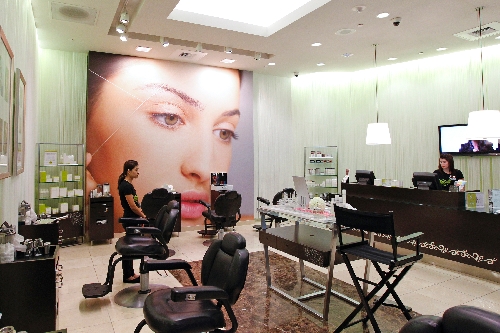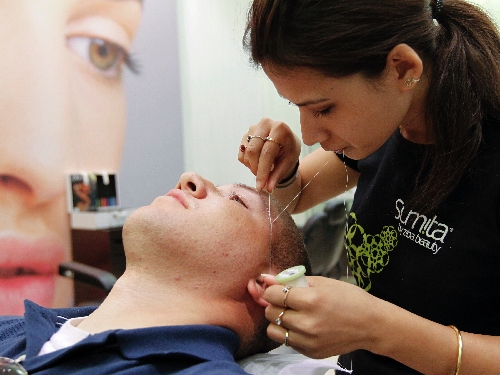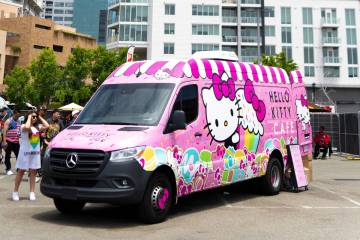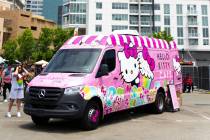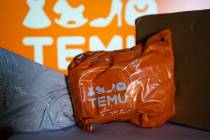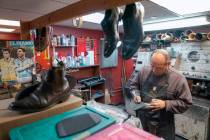Pioneering threading boutique the latest of dozens to open in Las Vegas
Six years ago, Las Vegas was introduced to an ancient Indian hair removal technique called "threading" and instantly hit it off. Consumers took very well to the frugal beauty service that uses nothing but thread to pull hair from the skin. As fast as positive word of mouth spread, new threading boutiques and kiosks spread faster.
Today our city boasts 28 threading operations, according to the Nevada State Board of Cosmetology. The latest to open, Sumita Beauty at Fashion Show mall, is a powerhouse force in the world of threading and henna (also known as mehndi) body art. With 16 studios in the United States, the brand plans to go global in the next five to seven years. Its CEO, Sumita Batra, takes credit for bringing threading to the United States and doesn't flinch at the slew of competition she has in Vegas.
"It's like asking what the difference is between Payless and Nike shoes," she says. "If you want the very best shoe, you will go to Nike."
She likens some of the stores' take-a-number customer service systems to that of the DMV and says it reminds her of her early days in L.A.'s Little India community, when a shower curtain provided privacy for the waxing area.
Sumita Beauty charges $11 for eyebrow threading and most everything else in the store (the number one signifies good luck in India), including brow pencils and fillers. Henna art starts at $10.
Batra was born in England, raised in Iran until age 10 when her family moved to India and finally settled in L.A. at 15.
She and her sister, Suman Patel, had been working in their mother Kundan Sabarwal's Indian studio, Ziba Beauty, eight years when a woman named L'Wren Scott dropped in for a henna service. Little did Batra know, that appointment would change her life.
Scott, then a fashion stylist and now an acclaimed fashion designer, posed on the red carpet at a few high-profile parties with her henna body art on full display. The spotlight it brought Ziba was a big deal, but Batra compares what happened next to the Indian food staple, basmati rice.
"Basmati rice actually has flavor. It's nothing like long grain rice," she says. "When you taste it for the first time it changes your world. That's what happened to me."
The year was 1997 when Scott styled a photo shoot for Vanity Fair magazine and suggested the cover girl, Liv Tyler, wear henna, courtesy of Batra. Batra went to the set expecting bagels and coffee. She got smoked salmon and poached eggs. She got famed photographer Herb Ritts arriving via helicopter. She got exposure she and her family never dared dream of. And, she got a craving for more.
Business boomed and Batra began wondering just how much bigger the boom could get. She got her answer in the form of video shoots for Madonna, "Saturday Night Live" appearances for Gwen Stefani, a henna art kit for The Body Shop and a book deal, "The Art of Mehndi."
By this time (2004), customers couldn't visit Ziba without waiting in a line that slithered out the door. Business logic screamed expansion. Within two years, six more salons opened. All the California facilities kept the name Ziba Beauty. Sumita Beauty, however, is the registered trademark and the name the business will take national, Las Vegas being the first among that effort.
Henna was the claim to fame for her mother's studio, but today it only accounts for 20 percent of requested services. The other 80 percent is threading. Batra explains this as two young men enter her new Vegas studio.
Kenny Smith and his buddy are visiting from Washington, D.C. Smith, 24, has heard of threading, but he normally gets his brows waxed.
Just a few short minutes after he has a seat, his appointment is halfway over. Smith looks in the mirror, happy with the results. "It feels better (than waxing)," he says. "And, it's a lot more accurate."
His feedback may justify why threading, and the businesses that perform it, has become so popular. It could also have something to do with the way the Nevada State Board of Cosmetology licenses these establishments. As of the last legislative session, they don't.
"(Threading establishments) were taken out from under the cosmetology board -- as far as regulations. But they still have to register with us," says Annie Curtis, chief inspector for the Nevada State Board of Cosmetology.
What does registering consist of? Filling out an application form. Unless a salon offers hair, skin or nail services, licensing isn't required. Although it's a dry process, Batra cites acne, open sores and rashes as potential hazards if a threader isn't sanitary. Kiosks especially concern her. "Where are they washing their hands?" she asks.
Last Friday Batra attended a hearing to enforce sanitation regulations on threading boutiques in Nevada. To her satisfaction, the initiative passed.
It's a step in the right direction, but Batra supports the state in their decision to remove threading from the cosmetology board's jurisdiction. Until cosmetology schools are teaching it, she says, they have no business regulating it.
That's why one of the Ziba studios in L.A. has an academy above it, where students study face types, proper brow shapes and technique. Her threaders can't work in her studios before undergoing a two-week training and passing a test issued by her sister.
Batra suspects Nevada hasn't incorporated threading into its curriculum yet because they still view it as a passing trend. Even though the state has 35 threading establishments and 72 threading practitioners. But, they'll catch on soon enough.
"Nail polish used to just be considered a Chinese art form," says Batra. "Threading will be like that."
If You Go
Sumita Beauty is located inside Fashion Show mall, 3200 Las Vegas Blvd. South, Suite 1820, 462-7980.



